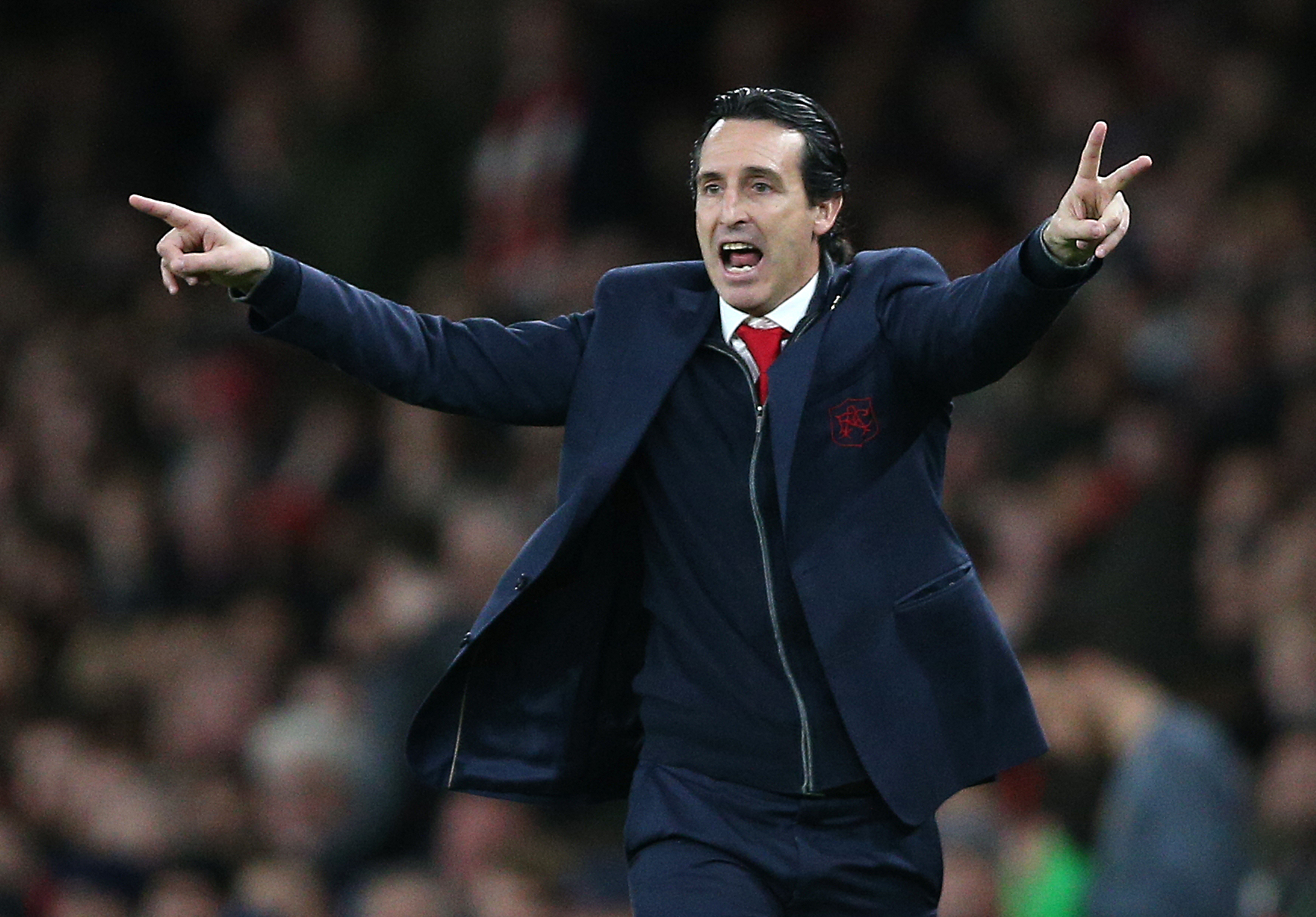Arsenal’s performances are stabilizing, but tactical weirdness remains in the form of dramatically better second half performances. Slowly but surely things are improving at Arsenal. They might be winning less than they were earlier in the season, but their level of play has become more consistent even as their results have hiccuped. As it stands Arsenal sit fifth in the table with 34 points, behind Chelsea only on goal difference with North London rivals Tottenham only two points ahead in third. That largely lines up with what expected goals predicts as well. Arsenal currently have an xG difference of 0.28 per game, the fifth best in the league. That isn’t to say that manager Unai Emery has solved all of Arsenal’s problems. The team's defense is still disturbingly sieve like. Opponents run up 1.16 xG per match, that’s not nearly stingy enough. There are nine Premier League teams that give up less than Arsenal defensively. But, you can get away with that to some degree when the attacking is firing for 1.43 xG per match, the fourth best total in the league. Arsenal have settled into a high octane approach which suits their abundance of attacking talent well. And, things all seem to be moving in the right direction. 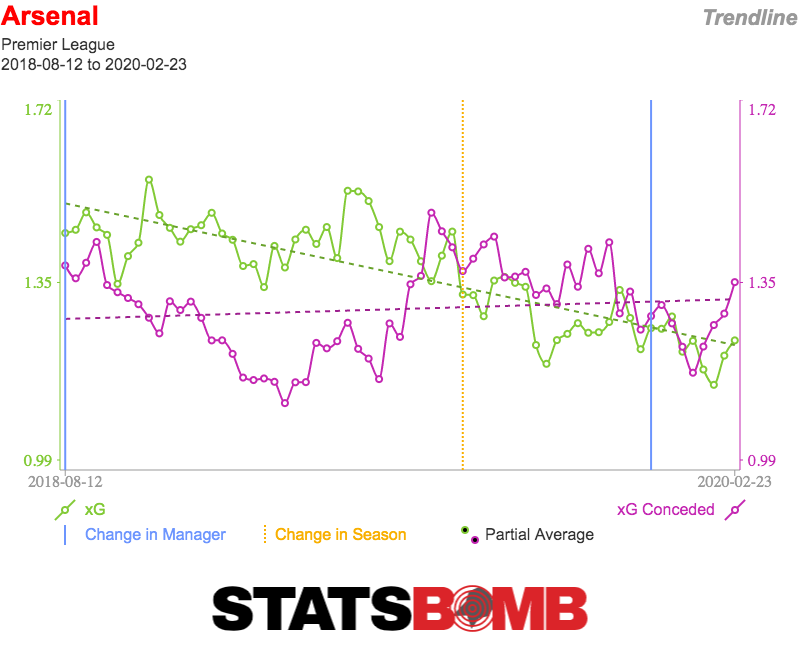 If there’s reason for concern it’s not in the bottom line. Fifth best by numbers, in the top four race and moving in the right direction might still be short of Arsenal’s ultimate ambitions but it’s a fine place to be approaching the midway point of Arsenal’s first season under new management. But, how they’re doing it is…well it’s weird. Arsenal’s success is coming despite not having led a single game at halftime. Does that mean anything? Is it just the football gods playing with Gunner emotions? Or is there something going on under the hood with Arsenal that’s leading to this exceedingly odd outcome? If there is some real tactical reason for the lopsidedness of Arsenal’s performance is it good or bad? Is Emery displaying the tactical acumen to rescue his teams from weak performances, or is he hampering them in the first half before getting out of the way later on? It does at least seem as if there’s something substantively different about Arsenal’s performances half to half. Here is Arsenal’s attacking output in the first half of games this season.
If there’s reason for concern it’s not in the bottom line. Fifth best by numbers, in the top four race and moving in the right direction might still be short of Arsenal’s ultimate ambitions but it’s a fine place to be approaching the midway point of Arsenal’s first season under new management. But, how they’re doing it is…well it’s weird. Arsenal’s success is coming despite not having led a single game at halftime. Does that mean anything? Is it just the football gods playing with Gunner emotions? Or is there something going on under the hood with Arsenal that’s leading to this exceedingly odd outcome? If there is some real tactical reason for the lopsidedness of Arsenal’s performance is it good or bad? Is Emery displaying the tactical acumen to rescue his teams from weak performances, or is he hampering them in the first half before getting out of the way later on? It does at least seem as if there’s something substantively different about Arsenal’s performances half to half. Here is Arsenal’s attacking output in the first half of games this season. 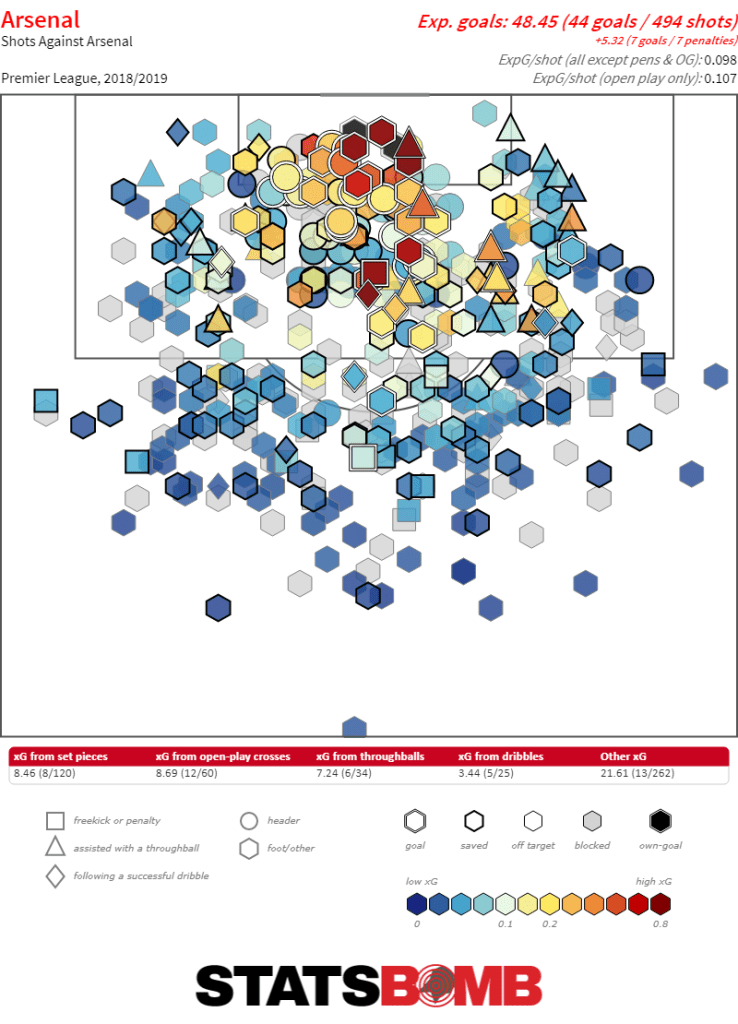 There’s not a lot to write home about there. It’s fine. Eight goals is about what you’d expect from the shots they’re taking. Their xG per shot is an unimpressive 0.086 which is why even though 97 shots total which works out to a 12 per match pace isn’t terrible, their xG is so uninspiring. It’s all just kind of meh. But, after the break, things improve dramatically.
There’s not a lot to write home about there. It’s fine. Eight goals is about what you’d expect from the shots they’re taking. Their xG per shot is an unimpressive 0.086 which is why even though 97 shots total which works out to a 12 per match pace isn’t terrible, their xG is so uninspiring. It’s all just kind of meh. But, after the break, things improve dramatically. 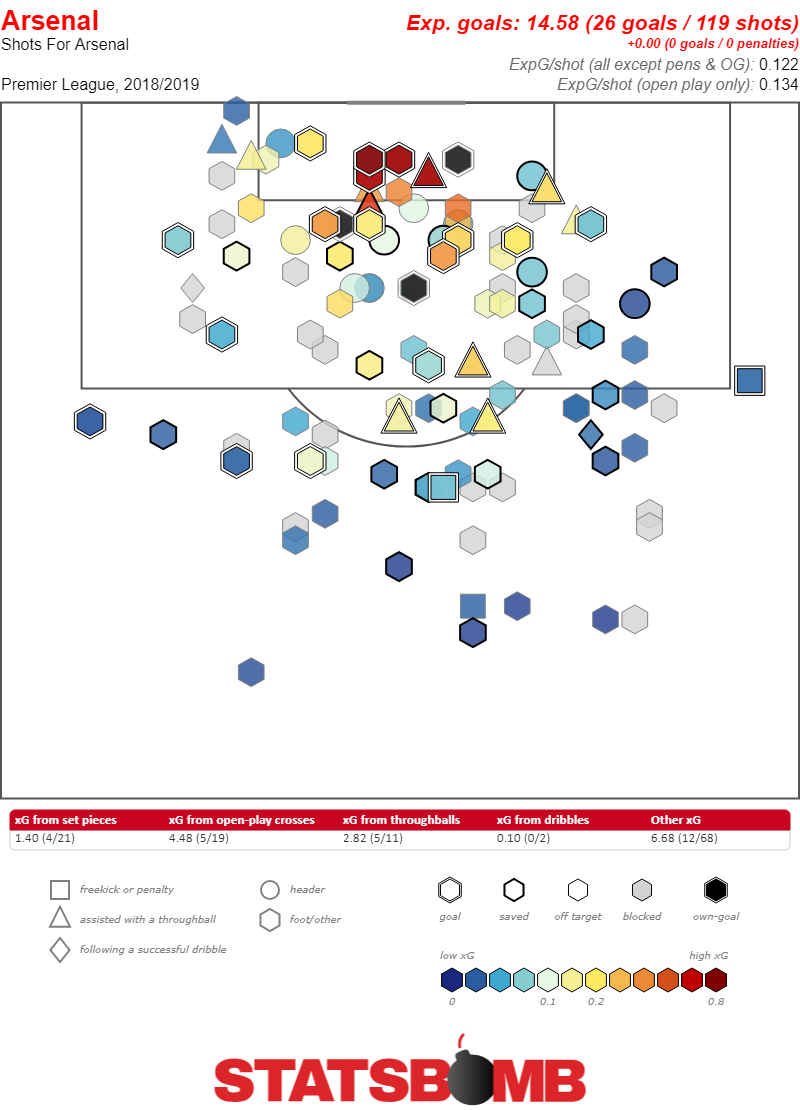 They’re obviously running hot, but they’re also producing a lot more. More shots, more xG, and a better xG per shot ratio. Everything improves. Drill down a little deeper and we can isolate some of the change. Specifically, the way Arsenal play when they’re drawing is vastly different half to half. Here’s the first half.
They’re obviously running hot, but they’re also producing a lot more. More shots, more xG, and a better xG per shot ratio. Everything improves. Drill down a little deeper and we can isolate some of the change. Specifically, the way Arsenal play when they’re drawing is vastly different half to half. Here’s the first half. 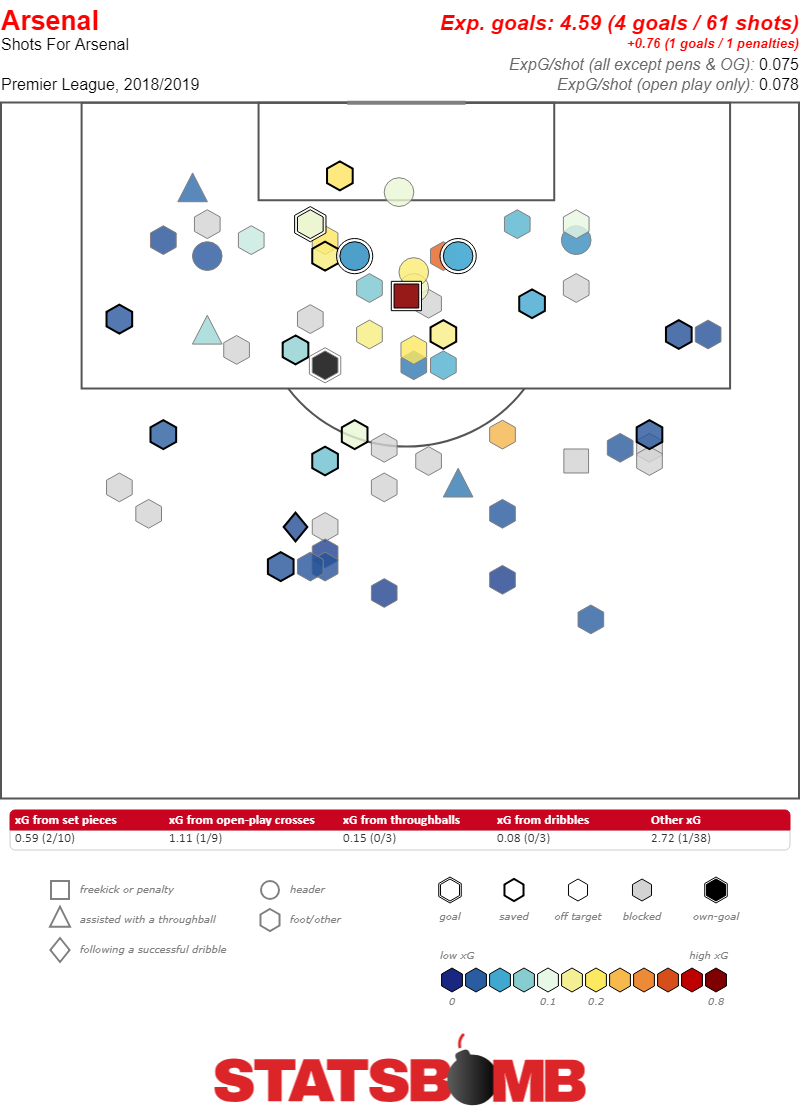 Again, not particularly inspiring. It’s fine, but 0.075 expected goals per shot is not the kind of attack on which successful teams are built, especially successful teams relying on their attack. The second half is better.
Again, not particularly inspiring. It’s fine, but 0.075 expected goals per shot is not the kind of attack on which successful teams are built, especially successful teams relying on their attack. The second half is better. 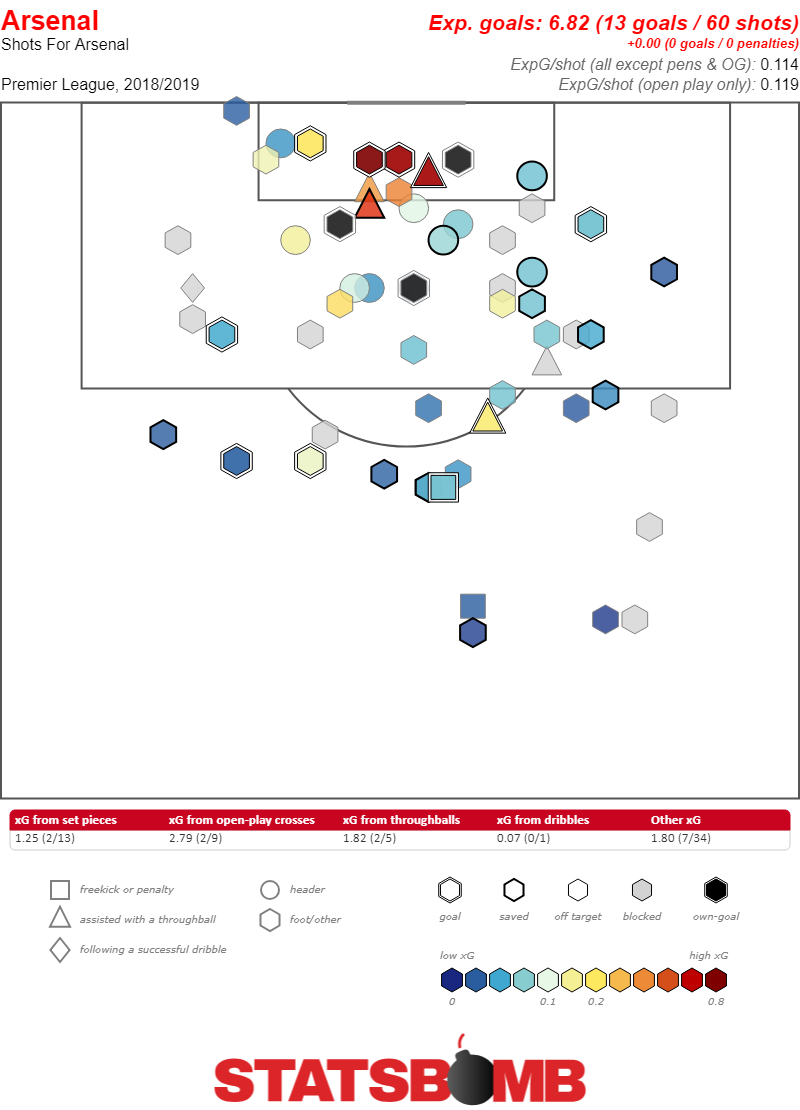 These numbers are obviously juiced by a ludicrous three own goals (and if you count the one in the first half, that makes four matches, or a full quarter of Arsenal’s games, where they’ve gone ahead through an own goal) but even so the jump from 0.075 xG per shot to 0.114 is no joke. So there’s something real going on there. But, at the same time that real tactical shift is also being exaggerated by a particular kind of bad luck. Here’s the shot map that Arsenal have faced when they’re leading in the first half.
These numbers are obviously juiced by a ludicrous three own goals (and if you count the one in the first half, that makes four matches, or a full quarter of Arsenal’s games, where they’ve gone ahead through an own goal) but even so the jump from 0.075 xG per shot to 0.114 is no joke. So there’s something real going on there. But, at the same time that real tactical shift is also being exaggerated by a particular kind of bad luck. Here’s the shot map that Arsenal have faced when they’re leading in the first half. 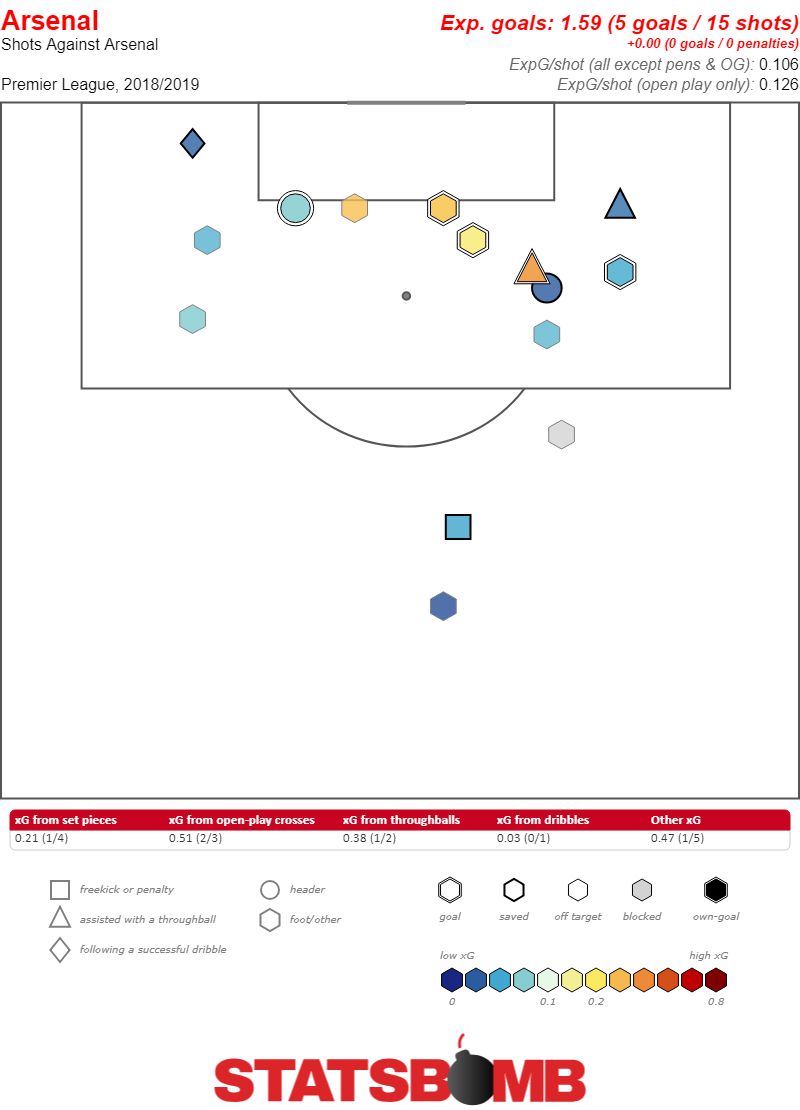 They’ve conceded five goals from a grand total of 15 shots! And not even particularly good shots. If they’d conceded the one or two you’d expect them to, well that’s a handful of games where they get to 45 minutes with a lead instead of getting pegged back. So, Arsenal really do approach the first half differently to the second half, although perhaps not so extremely differently as might be suggested by their weird record. The other thing to note in conjunction with the difference in halves is that Emery is, in fact, very aggressive when making substitutions. On average Arsenal make subs sooner than any other team in the Premier League.
They’ve conceded five goals from a grand total of 15 shots! And not even particularly good shots. If they’d conceded the one or two you’d expect them to, well that’s a handful of games where they get to 45 minutes with a lead instead of getting pegged back. So, Arsenal really do approach the first half differently to the second half, although perhaps not so extremely differently as might be suggested by their weird record. The other thing to note in conjunction with the difference in halves is that Emery is, in fact, very aggressive when making substitutions. On average Arsenal make subs sooner than any other team in the Premier League. 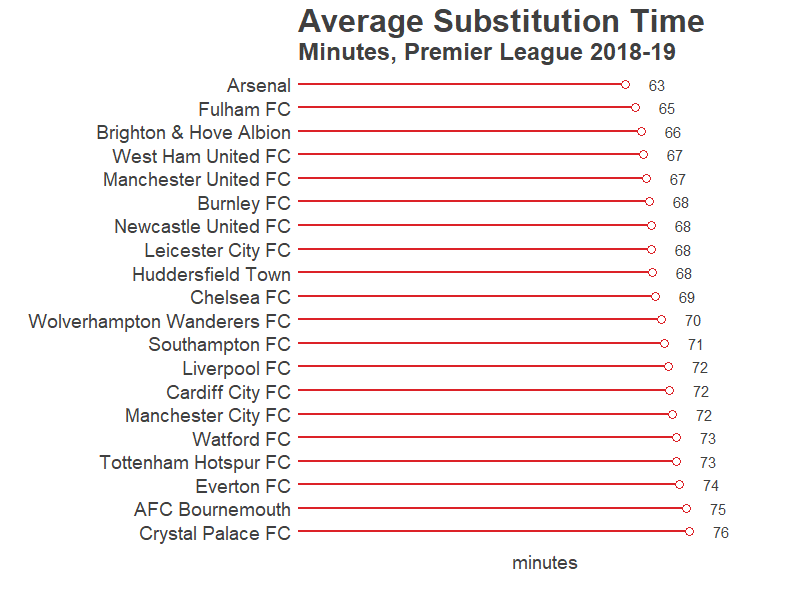 Disentangling cause and effect here is difficult. Would Emery’s substitutions be as dramatic is the team wasn’t running badly the times they do go ahead? It’s hard to say. Similarly, is Emery choosing the wrong lineups and then correcting them, or is he actively choosing an approach which gets substantially less conservative as the game goes on? That’s not unusual. Lots of managers, even managers of teams with substantial attacking talent, like to keep it tight for an hour before pouring it on late in the match. The numbers don’t solve the chicken and egg problem of whether Emery’s tactical changes are in reaction to Arsenal’s performance, or causing them, or some combination of both, but they do show that there’s a chicken and egg problem to solve. The difference between Arsenal in the first half and Arsenal in the second half is pretty vast. The reasons for that difference, like the reasons for most things, fall firmly in the gray area between total randomness and being completely within the team’s control. They’re playing differently, but they’re also getting unlucky in ways which are magnifying that difference. Throw a manager who is willing to aggressively react and use substitutions to change the makeup of the team into that stew and you’ve got Arsenal. They’re pretty good. They’re pretty weird. But if being pretty weird is the worst thing you can say about the Gunners, that’s a lot better than where they were a couple of months ago. Header image courtesy of the Press Association
Disentangling cause and effect here is difficult. Would Emery’s substitutions be as dramatic is the team wasn’t running badly the times they do go ahead? It’s hard to say. Similarly, is Emery choosing the wrong lineups and then correcting them, or is he actively choosing an approach which gets substantially less conservative as the game goes on? That’s not unusual. Lots of managers, even managers of teams with substantial attacking talent, like to keep it tight for an hour before pouring it on late in the match. The numbers don’t solve the chicken and egg problem of whether Emery’s tactical changes are in reaction to Arsenal’s performance, or causing them, or some combination of both, but they do show that there’s a chicken and egg problem to solve. The difference between Arsenal in the first half and Arsenal in the second half is pretty vast. The reasons for that difference, like the reasons for most things, fall firmly in the gray area between total randomness and being completely within the team’s control. They’re playing differently, but they’re also getting unlucky in ways which are magnifying that difference. Throw a manager who is willing to aggressively react and use substitutions to change the makeup of the team into that stew and you’ve got Arsenal. They’re pretty good. They’re pretty weird. But if being pretty weird is the worst thing you can say about the Gunners, that’s a lot better than where they were a couple of months ago. Header image courtesy of the Press Association
2018
What Happens to Arsenal at Halftime?
By Kevin Lawson
|
December 14, 2018
